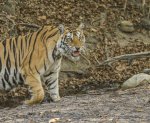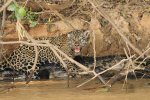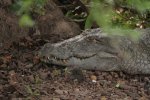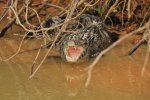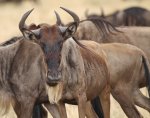Your First Safari ?...
I hesitate to advise anybody on safari-type holidays…. they are so variable in more ways than one. It depends very much on your expectations. My personal vision of a safari was a group of people sitting in a dusty old jeep in the middle of nowhere looking at a herd of buffalo or maybe those wildebeest that everyone seems to know about. And yes, it can be just like that……..
For Lions, and other cats such as Leopards, Cheetahs and the smaller cats, along with the huge variety of other birds and beasts on the menu, Africa is the best place. No travel company or travel writer would guarantee you seeing a particular species of wildlife anywhere…. simply, the wonder of wild animals is that you go to see them in their home, where they are free to wander and do exactly what they want, and when. Whilst tourism is rightly criticised, it does help the economy and limits the time for poachers getting in and out unnoticed, but for us it habituates the animals, i.e. they get used to us, and providing we adopt the rules of the guides, safe distances, etc., they are not dangerous and you can often experience these creatures quite close….. remember that cats (big and small) are inquisitive by nature…. they will often come to inspect you!
So, where to go in Africa….. a big choice.
There is Uganda and Rwanda if you have a burning desire to see Mountain Gorillas. Just to see them on a short 3 /4 day trip is very expensive; to extend it with general wildlife would be better value. Please remember, you will be told that there are guides who will carry your bags and camera gear if necessary , but you may have to trek for 2/3 hours on fairly rough tracks and it is very hot…you need to be quite fit.
Many holiday companies will offer you Namibia and Botswana ….. names like Chobe National Park, Etosha National Park, and more recently the spectacular Bale Mountains in Ethiopia are all musts on any wildlifer’s bucket list, but maybe not for the first trip.
For a virtually guaranteed abundance of wildlife viewing, Northern Tanzania is hard to beat. The vast plains are home to a huge variety of animals; probably the best place to see the ‘Big 5’. From the Western Corridor, near Lake Mwanza, through the Serengeti, Ngorogoro Crater, Tarangire to Lake Manyara, and Arusha near to Mount Kilimanjaro, is a magical journey through variable terrain of breathtaking beauty….. the term ‘animal paradise’ is not misplaced here.
India for tigers….
For Tigers, there is only one place… India. There are Amur (Siberian) Tigers in the wilds of Eastern Russia and China, but that is for the very experienced and they are rarely seen; definitely not your first wildlife holiday. The other big cat, the Asiatic Lion, can be seen in the Gujarat in Western India, but again this is a little remote and difficult to link in with other destinations in that vast country.
So, if Tigers are THE most important animals on your bucket list, and you only have one opportunity, you must include Bandhavgarh National Park on your itinerary. It has always yielded good sightings for us over many trips, but you need 3/4 games drives over a period of 2/3 days to maximise your chances. There are a number of good National Parks in the same state of Madhya Pradesh; they are … Kanha, Pench, Panna and Satpura. Combining some of these will minimise internal journey times, but India is a huge country and even those places mentioned are quite a few hours apart. If you wish to combine some culture with your wildlife, Ranthambore NP in Rajasthan, with visits to the Taj Mahal, Jodpur and Jaipur are in most travel companies’ brochures.
Other places…
South America, Brazil for example, has the fabulous Jaguar and a myriad of exotic birds. Chile has the equally wonderful Puma. Either of these locations are well tried and tested. We can talk about these another time.
So, the important things :
If this is likely to be your one and only safari, think seriously about what you would ideally like to see. Are you a ‘birder’ ?.... a big cat lover ? ….. or just a lover of all wildlife?
Then, where is the best place to go ?…. for how long ?… and, importantly, what time of year?
Identify the type of vehicle(s) you will be in for the duration; this is important, particularly if you are a photographer.
What type of terrain you will be covering, and importantly ensuring you are fit enough, even if it is only climbing in and out of a jeep.
All good wildlife travel companies will advise you on clothing, footwear and other essentials, but don’t forget vaccinations…. make sure they are all up to date with your GP.
Think about the cost last, as this may put you off before you start your initial planning. It is difficult to compare ‘like-for-like’ anyway, unless you prepare a bespoke itinerary and get more than one company to quote.
Source a specialist wildlife tourist company. Many UK travel companies will ‘subcontract’ you out to a local company. This can be risky if you do not do your research. There are a number of small touring companies that we have used based in the country you want to visit. They are used as ‘ground agents’ to the larger UK based companies. By going directly, it can make the holiday affordable.


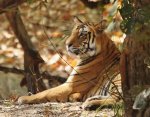
I hesitate to advise anybody on safari-type holidays…. they are so variable in more ways than one. It depends very much on your expectations. My personal vision of a safari was a group of people sitting in a dusty old jeep in the middle of nowhere looking at a herd of buffalo or maybe those wildebeest that everyone seems to know about. And yes, it can be just like that……..
For Lions, and other cats such as Leopards, Cheetahs and the smaller cats, along with the huge variety of other birds and beasts on the menu, Africa is the best place. No travel company or travel writer would guarantee you seeing a particular species of wildlife anywhere…. simply, the wonder of wild animals is that you go to see them in their home, where they are free to wander and do exactly what they want, and when. Whilst tourism is rightly criticised, it does help the economy and limits the time for poachers getting in and out unnoticed, but for us it habituates the animals, i.e. they get used to us, and providing we adopt the rules of the guides, safe distances, etc., they are not dangerous and you can often experience these creatures quite close….. remember that cats (big and small) are inquisitive by nature…. they will often come to inspect you!
So, where to go in Africa….. a big choice.
There is Uganda and Rwanda if you have a burning desire to see Mountain Gorillas. Just to see them on a short 3 /4 day trip is very expensive; to extend it with general wildlife would be better value. Please remember, you will be told that there are guides who will carry your bags and camera gear if necessary , but you may have to trek for 2/3 hours on fairly rough tracks and it is very hot…you need to be quite fit.
Many holiday companies will offer you Namibia and Botswana ….. names like Chobe National Park, Etosha National Park, and more recently the spectacular Bale Mountains in Ethiopia are all musts on any wildlifer’s bucket list, but maybe not for the first trip.
For a virtually guaranteed abundance of wildlife viewing, Northern Tanzania is hard to beat. The vast plains are home to a huge variety of animals; probably the best place to see the ‘Big 5’. From the Western Corridor, near Lake Mwanza, through the Serengeti, Ngorogoro Crater, Tarangire to Lake Manyara, and Arusha near to Mount Kilimanjaro, is a magical journey through variable terrain of breathtaking beauty….. the term ‘animal paradise’ is not misplaced here.
India for tigers….
For Tigers, there is only one place… India. There are Amur (Siberian) Tigers in the wilds of Eastern Russia and China, but that is for the very experienced and they are rarely seen; definitely not your first wildlife holiday. The other big cat, the Asiatic Lion, can be seen in the Gujarat in Western India, but again this is a little remote and difficult to link in with other destinations in that vast country.
So, if Tigers are THE most important animals on your bucket list, and you only have one opportunity, you must include Bandhavgarh National Park on your itinerary. It has always yielded good sightings for us over many trips, but you need 3/4 games drives over a period of 2/3 days to maximise your chances. There are a number of good National Parks in the same state of Madhya Pradesh; they are … Kanha, Pench, Panna and Satpura. Combining some of these will minimise internal journey times, but India is a huge country and even those places mentioned are quite a few hours apart. If you wish to combine some culture with your wildlife, Ranthambore NP in Rajasthan, with visits to the Taj Mahal, Jodpur and Jaipur are in most travel companies’ brochures.
Other places…
South America, Brazil for example, has the fabulous Jaguar and a myriad of exotic birds. Chile has the equally wonderful Puma. Either of these locations are well tried and tested. We can talk about these another time.
So, the important things :
If this is likely to be your one and only safari, think seriously about what you would ideally like to see. Are you a ‘birder’ ?.... a big cat lover ? ….. or just a lover of all wildlife?
Then, where is the best place to go ?…. for how long ?… and, importantly, what time of year?
Identify the type of vehicle(s) you will be in for the duration; this is important, particularly if you are a photographer.
What type of terrain you will be covering, and importantly ensuring you are fit enough, even if it is only climbing in and out of a jeep.
All good wildlife travel companies will advise you on clothing, footwear and other essentials, but don’t forget vaccinations…. make sure they are all up to date with your GP.
Think about the cost last, as this may put you off before you start your initial planning. It is difficult to compare ‘like-for-like’ anyway, unless you prepare a bespoke itinerary and get more than one company to quote.
Source a specialist wildlife tourist company. Many UK travel companies will ‘subcontract’ you out to a local company. This can be risky if you do not do your research. There are a number of small touring companies that we have used based in the country you want to visit. They are used as ‘ground agents’ to the larger UK based companies. By going directly, it can make the holiday affordable.



Last edited:

